
Branchial hearts are accessory pumps that supplement the action of the systemic heart in a cephalopod's body. They are myogenic in nature. Branchial hearts are always in pairs located at the base of the gills. Each branchial heart consists of a single chamber. They pump blood through the gills via the afferent branchial veins. Since they only circulate venous blood, branchial hearts function under predominantly anaerobic conditions. Branchial hearts also appear to be involved in hemocyanin synthesis.
Each branchial heart is directly connected to a branchial heart appendage or pericardial gland. The action of the branchial hearts is necessary for the production of primary urine in these appendages via pressure filtration. Branchial hearts may have evolved from the pericardial glands of nautiloids, such as those still found in modern nautiluses.
References
- ^ Fiedler, A.; Schipp, R. (1987). "The role of the branchial heart complex in circulation of coleoid cephalopods". Experientia. 43 (5): 544–553. doi:10.1007/BF02143583. S2CID 3165383.
- ^ Cephalopoda Glossary. Tree of Life web project.
- Beuerlein, K.; Schimmelpfennig, Robert; Westermann, Bettina; Ruth, Peter; Schipp, Rudolf (1998). "Cytobiological studies on hemocyanin metabolism in the branchial heart complex of the common cuttlefish Sepia officinalis (Cephalopoda, Dibranchiata)". Cell and Tissue Research. 292 (3): 587–595. doi:10.1007/s004410051088. PMID 9582416. S2CID 33065779.
- Witmer, Astrid; Martin, Arthur W. (1973). "The fine structure of the branchial heart appendage of the cephalopod Octopus dofleini martini". Zeitschrift für Zellforschung und Mikroskopische Anatomie. 136 (4): 545–68. doi:10.1007/BF00307370. PMID 4346672. S2CID 27050110.
- Schipp, R.; Schmidt, H. R.; Fiedler, A. (1986). "Comparative cytochemical and pharmacological studies on the cholinergic innervation of the branchial heart of the cephalopod Sepia officinalis (L.)". Experientia. 42: 23–30. doi:10.1007/BF01975878. S2CID 19161306.
- Bourne, G. B.; Redmond, J. R.; Johansen, K. (1977). "Nautilus pompilius: branchial circulation enhanced by an auxiliary pumping mechanism". Experientia. 33 (11): 1453. doi:10.1007/BF01918802. S2CID 33164113.
| Cephalopod anatomy | ||||||||||||||
|---|---|---|---|---|---|---|---|---|---|---|---|---|---|---|
| Shell |
|    | ||||||||||||
| Mantle & funnel |
| |||||||||||||
| Head & limbs |
| |||||||||||||
| General |
| |||||||||||||
| Developmental stages: Spawn → Paralarva (Doratopsis stage) → Juvenile → Subadult → Adult • Egg fossils • Protoconch (embryonic shell) | ||||||||||||||
This cephalopod-related article is a stub. You can help Misplaced Pages by expanding it. |